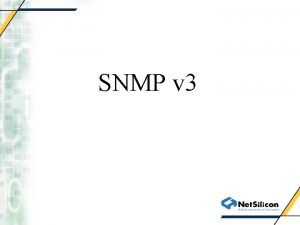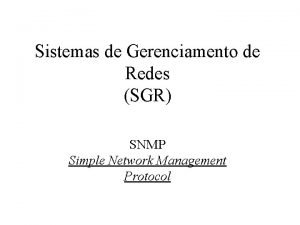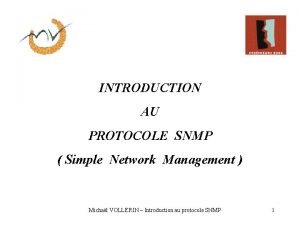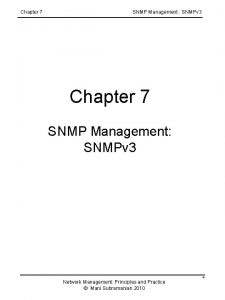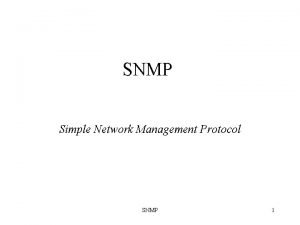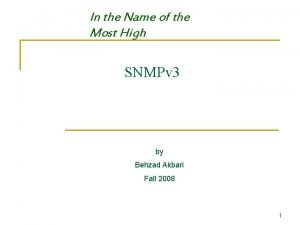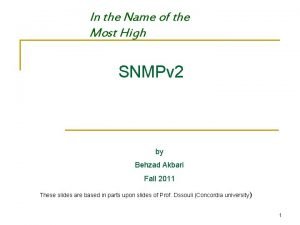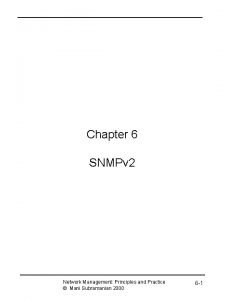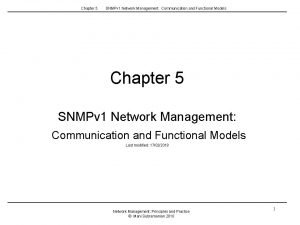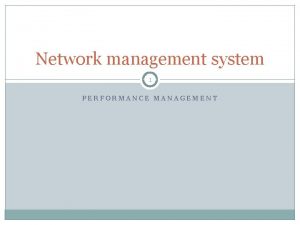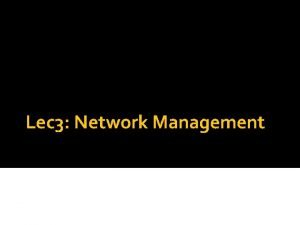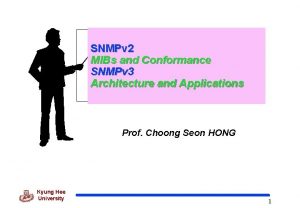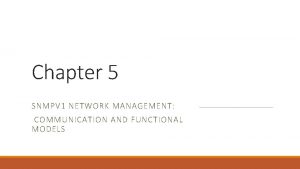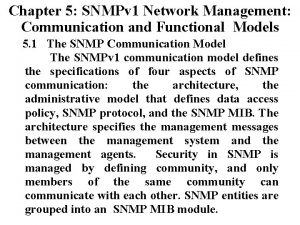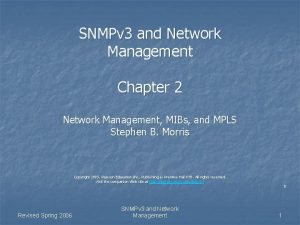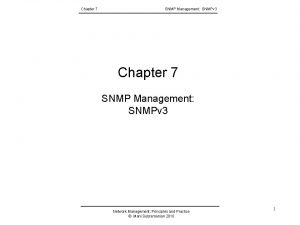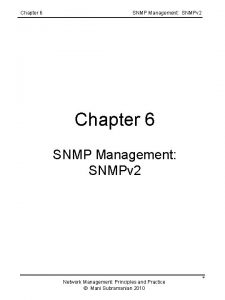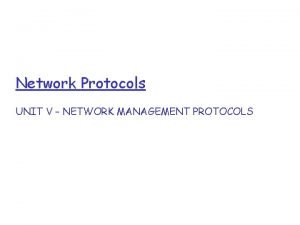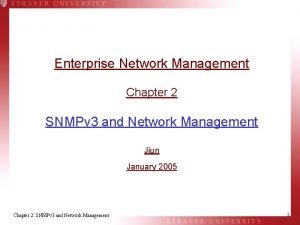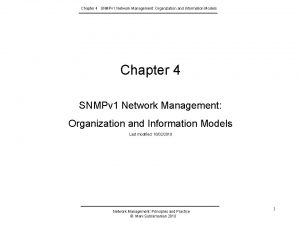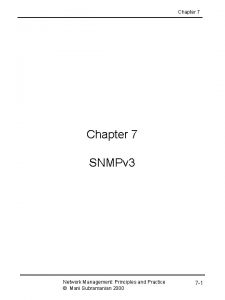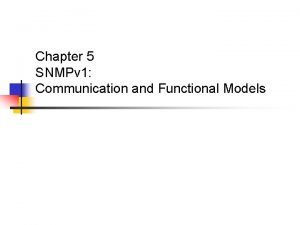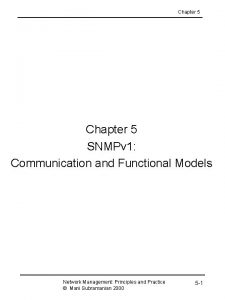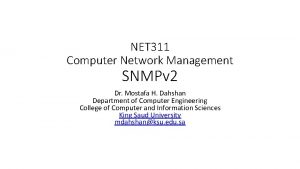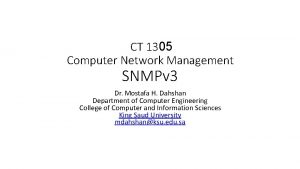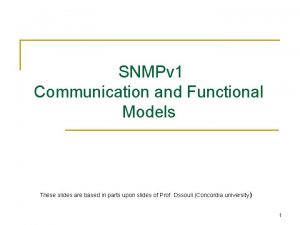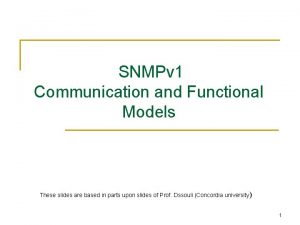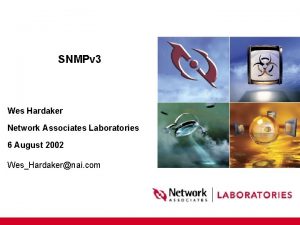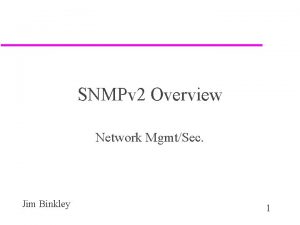Chapter 5 SNMPv 1 Network Management Communication and
























- Slides: 24

Chapter 5 SNMPv 1 Network Management: Communication and Functional Models Network Management: Principles and Practice © Mani Subramanian 2010 *

Chapter 5 SNMPv 1 Network Management: Communication and Functional Models Objectives • Communication model: Administrative and messages • Administrative structure • Community-based model • Access policy • MIB view • Message PDU • SNMP protocol specifications • SNMP operations • SNMP MIB • SNMP functional model Network Management: Principles and Practice © Mani Subramanian 2010 *

Chapter 5 SNMPv 1 Network Management: Communication and Functional Models SNMP Architecture Notes • Truly simple network management protocol • Five messages, 3 from manager and 2 from agent Network Management: Principles and Practice © Mani Subramanian 2010 *

Chapter 5 SNMPv 1 Network Management: Communication and Functional Models SNMP Messages • • • Get-Request Get-Next-Request Set-Request Get-Response Trap • Generic trap • Specific trap • Time stamp Notes • Generic trap • cold. Start • warm. Start • link. Down • link. Up • authenticationfailure • egp. Neighbor. Loss • enterprise. Specific • Specific trap • For special measurements such as statistics • Time stamp: Time since last initialization Network Management: Principles and Practice © Mani Subramanian 2010 *

Chapter 5 SNMPv 1 Network Management: Communication and Functional Models Administrative Model • Based on community profile and policy • SNMP Entities: • SNMP application entities - Reside in management stations and network elements - Manager and agent • SNMP protocol entities - Communication processes (PDU handlers) - Peer processes that support application entities Notes Network Management: Principles and Practice © Mani Subramanian 2010 *

Chapter 5 SNMPv 1 Network Management: Communication and Functional Models SNMP Community Notes • Security in SNMPv 1 is community based • Authentication scheme in manager and agent • Community: Pairing of two application entities • Community name: String of octets • Two applications in the same community communicate with each other • Application could have multiple community names • Communication is not secured in SNMPv 1 - no encryption Network Management: Principles and Practice © Mani Subramanian 2010 *

Chapter 5 SNMPv 1 Network Management: Communication and Functional Models Community Profile Notes • MIB view • An agent is programmed to view only a subset of managed objects of a network element • Access mode • Each community name is assigned an access mode: read-only and read-write • Community profile: MIB view + SNMP access mode • Operations on an object determined by community profile and the access mode of the object • Total of four access privileges • Some objects, such as table and table entry are non-accessible Network Management: Principles and Practice © Mani Subramanian 2010 *

Chapter 5 SNMPv 1 Network Management: Communication and Functional Models Administrative Model • Administrative model is SNMP access policy • SNMP community paired with SNMP community profile is SNMP access policy Notes Parameters: • Community / communities • Agent / Agents • Manager / Managers Network Management: Principles and Practice © Mani Subramanian 2010 *

Chapter 5 SNMPv 1 Network Management: Communication and Functional Models Access Policy Notes • Manager manages Community 1 and 2 network components via Agents 1 and 2 • Agent 1 has only view of Community Profile 1, e. g. , Cisco components • Agent 2 has only view of Community Profile 2, e. g. , 3 Com components • Manager has total view of both Cisco and 3 Com components Network Management: Principles and Practice © Mani Subramanian 2010 *

Chapter 5 SNMPv 1 Network Management: Communication and Functional Models Generalized Administrative Model Notes • Manager 1 manages community 1, manager 2 community 2, and manager 3 (Mo. M) both communities 1 and 2 Network Management: Principles and Practice © Mani Subramanian 2010 *

Chapter 5 SNMPv 1 Network Management: Communication and Functional Models Proxy Access Policy Notes • Proxy agent enables non-SNMP community elements to be managed by an SNMP manager. • An SNMP MIB is created to handle the non-SNMP objects. Network Management: Principles and Practice © Mani Subramanian 2010 *

Chapter 5 SNMPv 1 Network Management: Communication and Functional Models Protocol Entities Notes • Protocol entities support application entities • Communication between remote peer processes • Message consists of: • Version identifier • Community name • Protocol Data Unit • Message encapsulated and transmitted Network Management: Principles and Practice © Mani Subramanian 2010 *

Chapter 5 SNMPv 1 Network Management: Communication and Functional Models Get and Set PDU Notes • Var. Bind. List: multiple instances of Var. Bind pairs PDU Types: enumerated INTEGER Network Management: Principles and Practice © Mani Subramanian 2010 *

Chapter 5 SNMPv 1 Network Management: Communication and Functional Models Error in Response Error Index: No. of Var. Bind that the first error occurred Notes Network Management: Principles and Practice © Mani Subramanian 2010 *

Chapter 5 SNMPv 1 Network Management: Communication and Functional Models Trap PDU Figure 5. 8 Get and Set Type PDUs Table 5. 1 Generic Traps Notes • Enterprise and agent address pertain to the system generating the trap • Seven generic traps specified by enumerated INTEGER • Specific trap is a trap not covered by enterprise specific trap • Timestamp indicates elapsed time since last reinitialization Network Management: Principles and Practice © Mani Subramanian 2010 *

Chapter 5 SNMPv 1 Network Management: Communication and Functional Models SNMP Operations Notes Network Management: Principles and Practice © Mani Subramanian 2010 *

Chapter 5 SNMPv 1 Network Management: Communication and Functional Models MIB for Get-Next-Request Notes Network Management: Principles and Practice © Mani Subramanian 2010 *

Chapter 5 SNMPv 1 Network Management: Communication and Functional Models Lexicographic Order Table 5. 2 Lexicographic-Order Number Example Notes • Procedure for ordering: • Start with leftmost digit as first position • Before increasing the order in the first position, select the lowest digit in the second position • Continue the process till the lowest digit in the last position is captured • Increase the order in the last position until all the digits in the last position are captured • Move back to the last but one position and repeat the process • Continue advancing to the first position until all the numbers are ordered • Tree structure for the above process Network Management: Principles and Practice © Mani Subramanian 2010 *

Chapter 5 SNMPv 1 Network Management: Communication and Functional Models MIB Lexicographic Order Figure 5. 12 MIB for Operation Examples in Figures 5. 13 and 5. 15 Notes A B T E 1. 1 1. 2 2. 1 2. 2 3. 1 3. 2 Z Network Management: Principles and Practice © Mani Subramanian 2010 *

Chapter 5 SNMPv 1 Network Management: Communication and Functional Models A More Complex MIB Example Notes Network Management: Principles and Practice © Mani Subramanian 2010 *

Chapter 5 SNMPv 1 Network Management: Communication and Functional Models Get-Next-Request Operation Notes Network Management: Principles and Practice © Mani Subramanian 2010 *

Chapter 5 SNMPv 1 Network Management: Communication and Functional Models Get-Next-Request Operation Notes Network Management: Principles and Practice © Mani Subramanian 2010 *

Chapter 5 SNMPv 1 Network Management: Communication and Functional Models Sniffer Data Network Management: Principles and Practice © Mani Subramanian 2010 *

Chapter 5 SNMPv 1 Network Management: Communication and Functional Models SNMP MIB Notes • SNMPv 1 MIB has too many objects that are not used • SNMPv 2 obsoleted a large number of them Note: Most of the MIB objects were not used and hence deprecated in SNMPv 2 Network Management: Principles and Practice © Mani Subramanian 2010 *
 Snmpv
Snmpv Snmpv
Snmpv Snmpv
Snmpv Snmpv
Snmpv Snmpv
Snmpv Snmpv
Snmpv Snmpv
Snmpv Snmpv
Snmpv Network management principles and practice
Network management principles and practice Snmpv
Snmpv Network performance management functions
Network performance management functions Network accounting management
Network accounting management Public switched telephone network notes
Public switched telephone network notes Network management definition
Network management definition Datagram switching
Datagram switching Features of peer to peer network and client server network
Features of peer to peer network and client server network Network centric computing
Network centric computing What is oral communication and written communication
What is oral communication and written communication Definition of oral communication
Definition of oral communication Serial and parallel communication
Serial and parallel communication Network topologies
Network topologies Ece 526
Ece 526 Circuit switched vs packet switched
Circuit switched vs packet switched Top management middle management first line management
Top management middle management first line management Top management middle management first line management
Top management middle management first line management
